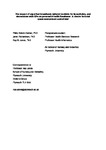The Impact of Superfast Broadband, Tailored Booklets for Households, and Discussions With General Practitioners on Personal Electronic Health Readiness: Cluster Factorial Quasi-Randomized Control Trial.
| dc.contributor.author | Abbott-Garner, P | |
| dc.contributor.author | Richardson, Janet | |
| dc.contributor.author | Jones, Ray | |
| dc.date.accessioned | 2019-03-19T09:46:43Z | |
| dc.date.issued | 2019-03-11 | |
| dc.identifier.issn | 1438-8871 | |
| dc.identifier.issn | 1438-8871 | |
| dc.identifier.other | ARTN e11386 | |
| dc.identifier.uri | http://hdl.handle.net/10026.1/13496 | |
| dc.description.abstract |
BACKGROUND: Electronic health (eHealth) may improve health outcomes, but many people remain digitally excluded. Personal readiness to use the internet for health may be limited by lack of internet infrastructure, personal skills, social support, service provision, and cost. The impact of interventions to reduce these barriers is unknown. From 2011, the British Government supported the implementation of "superfast" broadband (Superfast) across the rural county of Cornwall. This provided the opportunity to assess the impact of interventions at regional, practice, and household levels. OBJECTIVE: This study aimed to assess the impact of 3 interventions on personal eHealth readiness: (1) regional-level implementation of Superfast, (2) practice-level discussions with general practitioners to encourage greater internet use in health service provision, and (3) household-level tailored booklets providing information to help improve personal skills in eHealth. METHODS: This was a cluster quasi-randomized factorial controlled trial. Implementation of Superfast was monitored, and postcodes were classified as having early or late availability. An algorithm selected 78 from 16,385 eligible postcodes to minimize the possibility of overlap between general practices and ensure a balance of urban and rural areas; 1388 households were randomly selected from the 78 postcodes and allocated to the 8 (2 × 2 × 2) study arms. A modified version of the Personal eHealth Readiness Questionnaire was used to compare scores (0 to 10) and 4 components (personal, provision, support, and economic) from baseline (August 2013) to the 18-month follow-up between the 8 arms, to assess the impact of interventions. We compared SDs of scores to assess changes in eHealth inequalities. RESULTS: eHealth readiness improved over 18 months from 4.36 out of 10 to 4.59 out of 10 (t235=4.18; P<.001; CI=0.13 to 0.35), resulting from increases in personal and provision components of the score (t255=3.191; P=.002 and t258=3.410; P=.001). However, there were no significant differences between the 3 interventions, either singly or in combination using intention-to-treat analysis. The proportion of internet users did not significantly increase (79.2%, 205/259 to 81.5%, 211/259) and mobile use was significantly greater (50.5%, 101/199 to 64.8%, 129/199). There was no change in eHealth inequality. CONCLUSIONS: People in Cornwall became more ready to adopt eHealth services, increasing both their personal ability to use eHealth and their methods of access. The implementation of Superfast may have contributed to this; we are certain that our other 2 interventions did not. This increased eHealth readiness did not cause a larger digital divide. The study illustrates the complexity of conducting a randomized controlled trial to assess the impact of interventions at regional, practice, and household levels. Our method may be of use to others. TRIAL REGISTRATION: ClinicalTrials.gov NCT00102401; https://clinicaltrials.gov/ct2/show/NCT02355808 (Archived by WebCite at http://www.webcitation.org/75oEz0E1x). | |
| dc.format.extent | e11386-e11386 | |
| dc.format.medium | Electronic | |
| dc.language | en | |
| dc.language.iso | en | |
| dc.publisher | Journal of Medical Internet Research | |
| dc.subject | broadband implementation | |
| dc.subject | cluster trial | |
| dc.subject | digital divide | |
| dc.subject | eHealth | |
| dc.subject | eHealth inequalities | |
| dc.subject | eHealth readiness | |
| dc.subject | randomized controlled trial | |
| dc.subject | tailored booklet | |
| dc.title | The Impact of Superfast Broadband, Tailored Booklets for Households, and Discussions With General Practitioners on Personal Electronic Health Readiness: Cluster Factorial Quasi-Randomized Control Trial. | |
| dc.type | journal-article | |
| dc.type | Journal Article | |
| dc.type | Randomized Controlled Trial | |
| dc.type | Research Support, Non-U.S. Gov't | |
| plymouth.author-url | https://www.ncbi.nlm.nih.gov/pubmed/30855234 | |
| plymouth.issue | 3 | |
| plymouth.volume | 21 | |
| plymouth.publication-status | Published online | |
| plymouth.journal | Journal of Medical Internet Research | |
| dc.identifier.doi | 10.2196/11386 | |
| plymouth.organisational-group | /Plymouth | |
| plymouth.organisational-group | /Plymouth/Faculty of Health | |
| plymouth.organisational-group | /Plymouth/Faculty of Health/School of Nursing and Midwifery | |
| plymouth.organisational-group | /Plymouth/REF 2021 Researchers by UoA | |
| plymouth.organisational-group | /Plymouth/REF 2021 Researchers by UoA/UoA03 Allied Health Professions, Dentistry, Nursing and Pharmacy | |
| plymouth.organisational-group | /Plymouth/Research Groups | |
| plymouth.organisational-group | /Plymouth/Research Groups/Institute of Health and Community | |
| plymouth.organisational-group | /Plymouth/Users by role | |
| plymouth.organisational-group | /Plymouth/Users by role/Academics | |
| dc.publisher.place | Canada | |
| dcterms.dateAccepted | 2018-12-09 | |
| dc.rights.embargodate | 2019-3-27 | |
| dc.identifier.eissn | 1438-8871 | |
| dc.rights.embargoperiod | Not known | |
| rioxxterms.versionofrecord | 10.2196/11386 | |
| rioxxterms.licenseref.uri | http://www.rioxx.net/licenses/all-rights-reserved | |
| rioxxterms.licenseref.startdate | 2019-03-11 | |
| rioxxterms.type | Journal Article/Review |


